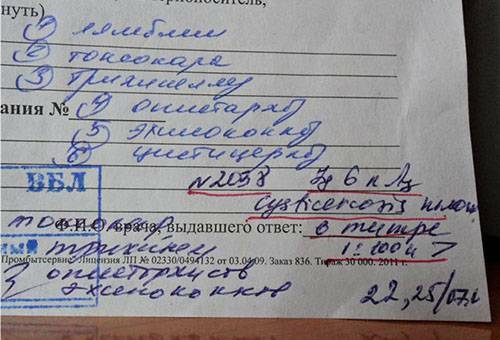Content:
- Preparation and collection of analysis
- How to store feces?
- When can not I keep a stool test?
- Why do I need to follow the rules?
- Alternative variants of
A coprogram is a stool analysis that allows you to evaluate the functioning of the digestive tract. Using a coprogram, you can get important information about the state of human health. From the fact whether the material was taken correctly, the interpretation of the result depends to a large extent. How to collect and store feces to get a reliable diagnosis?

Preparation and collection of
analysis Proper collection of stool analysis significantly affects the accuracy of the diagnosis. Even with all the rules of storage and transportation of analysis, you can get an unreliable result. If the technique of collection was violated at any stage, the accuracy of the diagnosis can no longer be guaranteed. How to properly collect the material for the study?
- Prepare a sterile container. It is best to buy a special container in the pharmacy. Some laboratories provide their customers with disposable containers for collecting analysis.
- Thoroughly treat the external genitalia with a soap solution or furacilin. Rinse skin with clean water.
- Use a clean and dry container( pot or vessel) for defecation.
- Take a small sample of stool( 5 cc see) and transfer it to a pre-prepared container. In pharmacy containers, a special spoon is provided for this.
- Close the container tightly.
Advice
Do not forget to empty the bladder before starting the analysis.
Stool analysis can not be done at any time. It is forbidden to collect material for examination in the following cases:
- earlier than 2 days after the cleaning enema;
- earlier than 2 days after a radiologic contrast study of the digestive tract;
- when using sorbents( activated charcoal and others) for several hours before defecation;
- in the case of taking laxatives a day before the planned study;
- when using rectal suppositories for medical purposes;
- in women during menstruation.

How to store feces?
Collect feces for any study should be in the early morning of the day when the analysis is scheduled to be delivered to the laboratory. Since the morning it is necessary to empty the intestines with observance of all the rules for collecting the material. In the next few hours, the sample should be delivered to a clinic or laboratory in a clean sterile container. You can deliver the material yourself or use courier service( if it is provided in the laboratory).
Is it possible to collect a feces analysis the night before, and in the morning to carry it to the laboratory? This option is allowed. It should be noted that even in this case, no more than 8 hours should pass between collecting the material for analysis and delivering it to the laboratory. Otherwise, the expected results of the coprogram may be unreliable.
How should I keep a stool test? It is recommended to keep the collected material in the refrigerator. It is best to place the analysis on the middle shelf. Do not leave the container on the side shelves of the refrigerator or place it too close to the freezer. The optimal temperature of storage of the container with the contents of the intestine is from +4 ºС to +8 ºС.
Freezing stool analysis is strictly prohibited! During freezing and subsequent defrosting, the material loses all its natural properties. Obtaining reliable information with such a study is almost impossible.
How much storage can I store the feces in the refrigerator? For ordinary coprogram the material can be left on the middle shelf of the refrigerator for 6-8 hours. Remember, within 8 hours the sample should be in the laboratory. Take into account the time that will need to be allocated to the road to the place of delivery of the container.

When can I not keep a stool sample?
Not always collected material can be stored in the refrigerator. Analysis of feces for dysbiosis is collected only in the morning and immediately delivered to a polyclinic or laboratory. The material for determining the intestinal microflora should be fresh: not all bacteria are able to survive long-term storage. When the sample is analyzed after 6 hours or more, the result will be unreliable.
How long does it take to store the feces collected to determine the intestinal microflora? Most laboratories recommend not delaying the delivery of the sample. Cal for dysbiosis can be stored in a refrigerator or in an ice pack for no more than 4-6 hours. Freezing of the material is not allowed.
Tip
Make sure that the lid of the container is tightly closed.
To detect lamblia, only fresh stool analysis is also used. Such material can not be stored in the refrigerator for more than 6 hours. The earlier the sample is delivered to the study, the more reliable the result will be. Some laboratories insist that the delivery of the container takes place within 2 hours after the bowel has been emptied. Before the examination, the consultant should specify the rules for taking the analysis in a specific laboratory.

Why do I need to follow the rules?
Many people who have frozen their feces or left it in the refrigerator for more than 8 hours get the wrong analysis results. Why is this happening? The thing is that with prolonged storage various microorganisms begin to multiply in the collected sample. Some bacteria, on the contrary, perish during storage. The chemical properties of the contents of the intestine also change: its structure, composition, content of certain substances. All this ultimately leads to incorrect interpretation of the results and the setting of incorrect diagnoses.
Very critical may be a violation of the technique of collecting material for dysbiosis or the detection of specific pathogenic microorganisms. Long-term storage, and even more so, freezing, samples will result in the sowing of quite incredible combinations of bacteria. In the best case, the doctor will send the patient to a second trial, at worst - will start the wrong treatment. To avoid this, you must follow all the subtleties of material collection and take into account the features of sample storage for various studies.

Alternatives for
If it is not possible to collect fresh feces or store it in the refrigerator, alternative methods of collecting the material for the study can be used. Instead of using containers in some cases, you can take a scraping from the rectal mucosa. The material is collected with a cotton swab and then placed in a closed test tube. The sample is delivered to the laboratory within the next two hours.
Unfortunately, scraping of the contents of the rectum allows us to identify not all diseases of the digestive tract. In some cases, without the usual collection of samples in the container can not do. Exact information on the possibility of conducting a particular study can be obtained from your doctor.
Read the article on how to store urinalysis



